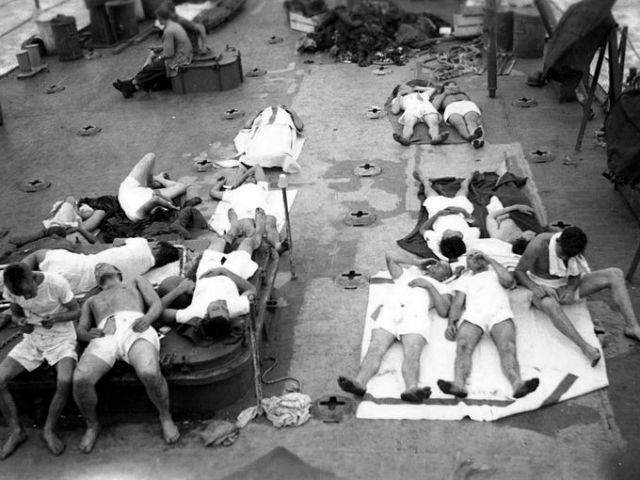Today is the 70th anniversary of the sinking of the USS Indianapolis, of one of the most terrible catastrophes in the history of the United States Navy. After completing a mission to deliver parts for the atomic bomb that would fall on Hiroshima, the battleship was struck by a torpedo from Japanese submarine I-58 en route to the Philippines. The Indianapolis sank, taking with it a over 300 crewman. The sinking launched a five-day ordeal in which just under 600 more sailors would be killed.
After the Indianapolis sank, crewmen endured days of exposure to the elements, dehydration—and most horrifyingly of all—shark attacks. The sheer amount of blood in the water surrounding the the ship’s debris set off a shark feeding frenzy.
CAPT Lewis L. Haynes, MC explained the feeling of dread and helplessness that the floating sailors endured while the days rolled by.
“There was nothing I could do but give advice, bury the dead, save the life jackets, and try to keep the men from drinking the salt water when we drifted out of the fuel oil,” Haynes said. “When the hot sun came out and we were in this crystal clear water, you were so thirsty you couldn’t believe it wasn’t good enough to drink. I had a hard time convincing the men that they shouldn’t drink.”
Captain Charles B. McVay, who survived the initial sinking by climbing on a potato crate and then hopping onto a lifeboat, described the experience of being hunted by sharks for days:
We have one boy who was bitten on the thigh. The group down there said that on the calm days, they knew there were sharks around because they could see them underneath. They didn’t actually seem to bother them on the surface. It was different with my group who were in rafts. We had a shark that adopted us apparently sometime in the early morning of Monday. We couldn’t get rid of him. The kids who were in rafts by themselves on this one raft were scared to death of this shark because he kept swimming underneath the raft. You could see his big dorsal fin and it was white, almost as white as a sheet of paper, apparently [the shark] spent most of his time on the surface and this fin had bleached out so he didn’t blend in with the water at all.
Another survivor, Woody E. James, said of the shark attacks, “You’d hear guys scream, especially late in the afternoon. Seemed like the sharks were the worst late in the afternoon than they were during the day. Then they fed at night too. Everything would be quiet and then you’d hear somebody scream and you knew a shark had got him.”
The survivors began to believe that they had been abandoned after days of floating in the water. Due to the secrecy of the mission, nobody had even been looking for the Indianapolis or was aware that it had disappeared. By a stroke of luck, Pilot Wilbur “Chuck” Gwinn was flying his PV-1 Ventura Bomber over what he thought was the oil slick of a disabled Japanese submarine, but it turned out to be the remaining crew members of the Indianapolis.
Survivor Dick Thelen said, according to NPR, “Chuck looked down at the exact same time they were flying over an oil slick. Now if he’d looked any other way or wouldn’t have flew that direction, he wouldn’t have seen us. None of us would have survived.”
The destroyer USS Cecil Doyle arrived to pick up most of the survivors, but only 321 of the original 1,196 crewmen remained. Though initially court-martialed, Captain McVay was cleared of charges that his decisions led to the disaster. Nevertheless, the incident became an enormous tragedy due to a number of unconnected mistakes. A distress call was sent out and received by three separate sources, but none of them acted upon the information. It has come to light that of those that received the distress signal, “one commander was drunk, another had ordered his men not to disturb him and a third thought it was a Japanese prank.”
The movie, Jaws, made the calamity of the Indianapolis sinking a part of popular culture. In one famous scene with shark hunter Quint, played by Robert Shaw, the old sea captain tells his story as one of the survivors. He explains what it was like to be hunted by sharks for five days and the “lifeless eyes, black eyes, like a doll’s eyes,” of the menacing creatures that will “rip you to pieces.”
Watch the video below:

COMMENTS
Please let us know if you're having issues with commenting.